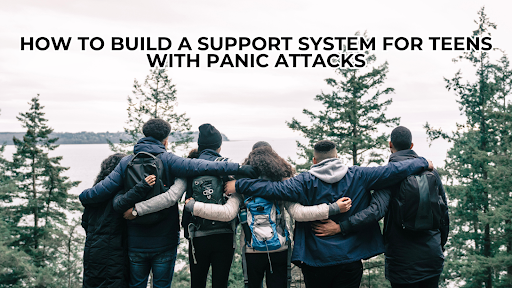How to Build a Support System for Teens With Panic Attacks

When panic strikes a teenager, it can feel like the world is crashing down around them. Panic attacks affect countless teens across America, creating intense fear and physical symptoms that disrupt their daily lives.
This blog explores how parents, friends, and educators can work together to create a strong support network for teenagers experiencing panic attacks. It offers practical strategies and understanding to help them navigate these challenging moments.
Understanding Teen Panic Attacks
The teenage years are already challenging, and panic attacks add another layer of difficulty. These intense episodes can strike without warning, leaving teens feeling scared, confused, and isolated from their peers. Many teenagers struggle silently with these experiences, unsure where to turn or how to explain what they’re going through.
Medical professionals emphasize the importance of early support for teens experiencing anxiety symptoms. Understanding the available options for panic attack teenager treatment helps families make informed decisions about their teen’s mental health care. Creating a supportive environment makes a significant difference in how teenagers cope with and overcome panic attacks.
Key Components of a Support System
- Family members play a crucial role by providing consistent emotional support and maintaining open communication. Parents should create a judgment-free space where teens feel safe discussing their feelings and experiences without fear of criticism or dismissal.
- Friends and classmates who understand panic attacks can offer invaluable peer support during school hours. Having someone to sit with during lunch or walk between classes reduces anxiety about potential panic attacks.
- Teachers and school counselors form the educational support backbone, helping to manage academic pressure while providing understanding during difficult moments.
Creating a Safe Home Environment
Home should feel like a sanctuary for teens dealing with panic attacks. Parents can establish regular check-ins without pressure, allowing their teenager to share concerns or fears when ready. These conversations build trust and understanding between family members.
Setting up a dedicated calm-down space gives teens a go-to spot when feeling overwhelmed. This area might include comfort items, breathing exercise reminders, or other personally meaningful objects that help during anxious moments.
| Support Element | Purpose | Benefits |
| Open Communication | Express feelings freely | Reduces isolation |
| Calm Space | Manage symptoms | Provides security |
| Regular Check-ins | Monitor well-being | Builds trust |
| Crisis Plan | Clear action steps | Increases confidence |
School-Based Support Strategies
The educational setting functions as an essential resource to assist students in handling panic attacks. Implementations from administrators create policies enabling students to take necessary breaks from classes without bringing notice to themselves. Staff education enables teachers to identify panic attacks and take proper steps in response to them.
School counselors must collaborate with educational staff members to arrange academic support modifications. Implementation of a supportive network among educational staff allows students to maintain their academic progress while dealing with symptoms.
Peer Education and Support
The instruction of panic attack knowledge to friends builds comprehension regarding this condition in their student population. Close friends tend to provide comfort when they know the proper steps to assist a person suffering from an episode. Public education related to panic attacks reduces discrimination and builds supportive actions among people.
Through peer support groups teens obtain chances to interact with peers who share similar experiences. These connections help normalize their experiences and provide practical coping strategies learned from peers.
School Success Planning
Teachers who help alternative assignments reduce student stress levels. Guidelines need to allow tests and presentations to be rescheduled or content delivery to adapt to new plans. When teens have backup learning strategies they can concentrate on education rather than panic attacks.
Both academic and emotional support become available to students through study groups with comprehension-oriented friends. Turning big assignments into smaller work components improves their skill in handling large projects. The monitoring system of teachers and regular meetings provide necessary adjustments to academic progress.
Professional Support Integration
Long-term achievement starts with creating relationships with mental health professionals. The monitoring process enabled by regular check-ins allows for response modifications when necessary. The entire support structure becomes stronger through guidance from professionals.
Healthcare providers should join families to establish detailed management strategies for their situation. Each plan takes a personalized approach to accommodate the individual requirements of teenagers together with their distinctive triggers or particular conditions.
Technology and Support Tools
Modern adolescents have access to panic attack management apps through their digital platforms. Digital tools enable teenagers to access various breathing exercises as well as relaxing music and stress management advice during times of crisis. Several young people get reassurance from digital support tools that they keep accessible on their mobile devices.
Through online platforms, students can locate groups where they find helpful peer support in their time of need. Members of these platforms let teenagers connect directly with others experiencing similar problems. Online platforms with moderation allow users to establish secure areas where they can exchange experiences and useful techniques.
Physical Activity Benefits
Moving the body helps release tension and nervous energy that builds up during anxious times. Simple activities like walking around the block or stretching can make a big difference when feeling panicky. Regular movement helps teens stay connected to their bodies and recognize early warning signs.
Team sports or group activities provide structured opportunities for social interaction. Physical activity with others helps build confidence and create positive associations with group settings. The natural endorphins from exercise contribute to overall well-being.
Empowering Self-Management
The implementation of self-management techniques throughout teen education enables them to develop competence in dealing with panic attacks. Identifying warning signs allows teens to prevent their symptoms from growing worse. Teenagers who understand what triggers their panic attacks can acknowledge situations where these attacks might occur.
Through learning healthy coping strategies young adults receive their own practical problem-solving abilities. Practice and repeated efforts allow teenagers to develop these capabilities which create enduring resilience together with independence.
Family Communication Strategies
Family meetings scheduled regularly present space for topics to be discussed before they intensify. Parents should talk about their experiences with stress tools because this helps teenage students realize they have social support from adults. Through open communication, all members learn the best ways to offer mutual support.
Teens can identify pre-planned phrases that act like signals to express their requirements when experiencing tough times. Family members need to exercise response plans under normal circumstances before emergencies. Well-defined communication channels ensure that people interpret each other correctly while under extreme stress.
Building Confidence Through Small Wins
Daily objective setting leads teenagers to build their self-assurance through appropriate progression. Achieving small milestones makes it possible to empower people through established coping behaviors. Empowering achievements builds a resource base that helps teens cope with upcoming issues.
A progress journal serves as a tool for monitoring how one progresses with their objectives. Evaluation of previous achievements shows teens the distance they have traveled through growth. People find encouragement through noted achievements that document their achievements during difficult moments.
Future Planning and Growth
The discussion of future aims enables young people to transcend their ongoing problems with panic attacks. College counselors together with career advisors create planning documents that include anxiety management needs for students. By looking toward the future teens find motivation to continue their effort toward coping skills.
Support plans created for the future make life changes less challenging. Students need to investigate the support services that exist inside the study and work facilities they consider. The act of planning helps individuals minimize their concerns about upcoming adjustments.
Frequently Asked Questions:
What signs indicate regular teenagers struggling from stress versus the occurrence of panic attacks to parents?
Whenever adolescent stress occurs it connects to a specific effort but adolescents generally maintain control over it while panic attacks emerge unexpectedly with physical manifestations including increased heart rate and difficulty breathing alongside a feeling of doom.
What should friends do when a classmate has a panic attack?
Friends should stay calm and offer reassurance, reminding their classmates that the panic attack will pass. They can encourage slow breathing, guide them to a quiet space, and avoid making dismissive comments instead of offering support and staying with them until the symptoms subside.
How can schools better support students with panic attacks?
Schools can train staff to recognize the signs of panic attacks and respond with empathy while providing safe spaces for students to calm down. Additionally, offering flexible policies for breaks and academic accommodations, and integrating mental health support into the school environment, can help students manage anxiety and perform better.


